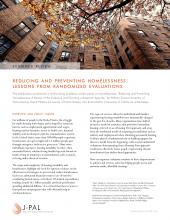Reducing and Preventing Homelessness: Lessons from Randomized Evaluations
Homelessness represents both a cause of and one of the more extreme outcomes of poverty and inequality. In the United States, more than 500,000 people experience homelessness on a given night and 1.4 million people pass through emergency shelters in a given year. Each year, substantial financial resources are devoted to combatting homelessness, with direct US federal expenditures totaling around $6.1 billion annually and local jurisdictions spending additional billions.
The types of services offered to individuals and families experiencing housing instability have dramatically changed in the past few decades, with rigorous evidence on the effectiveness of a Housing First approach playing a fundamental role in these policy changes. How can rigorous evaluation continue to drive improvements to policies and services aimed at helping people experiencing housing instability access and maintain stable, affordable housing?
J-PAL’s Evidence Review “Reducing and Preventing Homelessness: Lessons from Randomized Evaluations” highlights key research findings on policies to help people access and maintain stable, affordable housing and identifies research questions that remain to be answered. The publication synthesizes results from forty rigorous evaluations of eighteen distinct programs related to homelessness prevention and reduction in North America.
The Evidence Review summarizes an academic review paper on homelessness, “Reducing and Preventing Homelessness: A Review of the Evidence and Charting a Research Agenda,” by William Evans (University of Notre Dame), David Phillips (University of Notre Dame), and Krista Ruffini (University of California at Berkeley).
Key results from the Evidence Review are as follows:
- Emergency financial assistance and more comprehensive interventions that provide a range of financial assistance, counseling, and legal supports can prevent homelessness among families at risk of losing their homes, but more research is needed on how prevention programs can best be delivered and targeted towards those most in need.
- Legal representation for tenants facing eviction holds promise for improving court-related outcomes for tenants and reducing evictions, although more research is needed on which types of legal tactics and programs are effective.
- Permanent supportive housing increases housing stability for individuals with severe mental illness and for veterans experiencing homelessness. There is limited rigorous evidence on the impact of permanent supportive housing for other groups of people.
- Although rapid re-housing is a potentially cost-effective solution to provide immediate access to housing, there is limited rigorous evidence on the impacts of rapid re-housing on long-term housing stability.
- Subsidized long-term housing assistance in the form of Housing Choice Vouchers helps low-income families avoid homelessness and stay stably housed.
- Additional research on the effectiveness of other strategies to reduce homelessness is needed. This review identifies gaps in the literature and poses several new questions to be considered when conducting evaluations of homelessness prevention or assistance programs.
